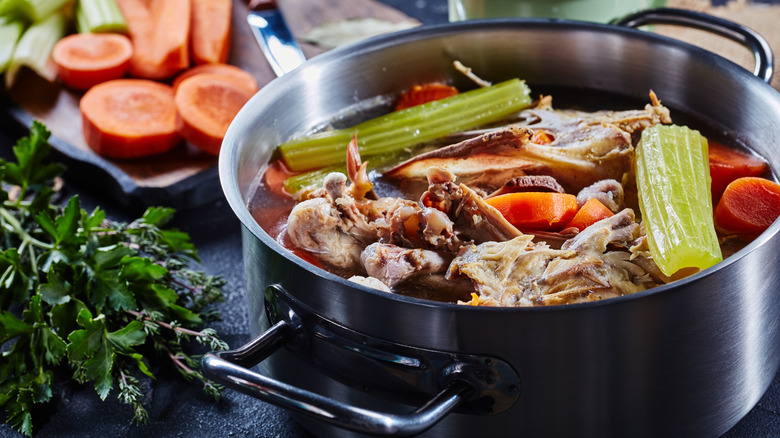Start Roasting Leftover Meat Bones For Better Broth
Broth has proven itself as a mainstay in the health food space, but it never needed to. A high-quality bone broth can elevate any dish or just be enjoyed on its own in a mug. Broth has been the base of sauces, soups, and stews since the early days of cuisine, per Ossa Organic, and is often used in a medicinal capacity as well. Why let bones go to waste when you can leech every last nutrient out of them and turn it into a tasty staple?
If you've ever embarked on making your own homemade broth, perhaps you've visited the butcher for some bones or the freezer aisle at the grocery store. Maybe you've held onto the wing bones after a football Sunday or last week's rotisserie chicken. Dubbed "liquid gold", nothing beats a batch of homemade bone broth simmering away on the stove. If you're looking to elevate the flavor of your next stock pot's worth, popping those bones in the oven before on the stovetop will do a world of wonders. Why?
Roasting adds richness
Roasting the bones you use for your homemade broth will deepen the flavor exponentially. The extra step adds a richer and fuller taste of what kind of meat was on those bones with a deeper color. The roasting activates the Maillard reaction, which is a chemical reaction between the proteins and sugar that adds a rich, full-bodied flavor to the broth, per Jessica Gavin.
Steak School suggests blasting them in the oven at a high temperature (about 450 degrees Fahrenheit) for about an hour, flipping halfway through. Don't overcrowd the pan by making sure there is space between the bones to encourage browning and caramelization in lieu of steaming.
This begs the question — if you're using bones from a chicken or piece of meat that's already been roasted, do you still need to roast them to make broth? Need to? Probably not, per Natasha's Kitchen. Will the broth benefit and taste richer if you do choose to pop them in the oven and caramelize them? Absolutely.

